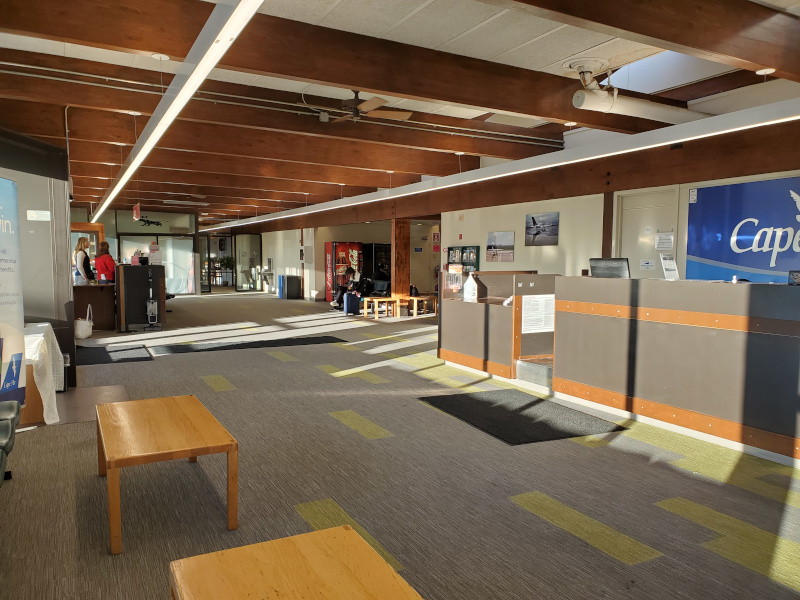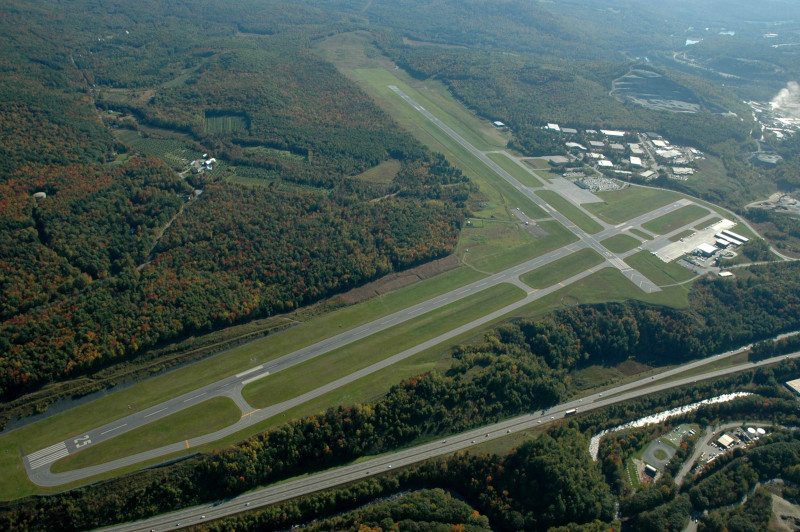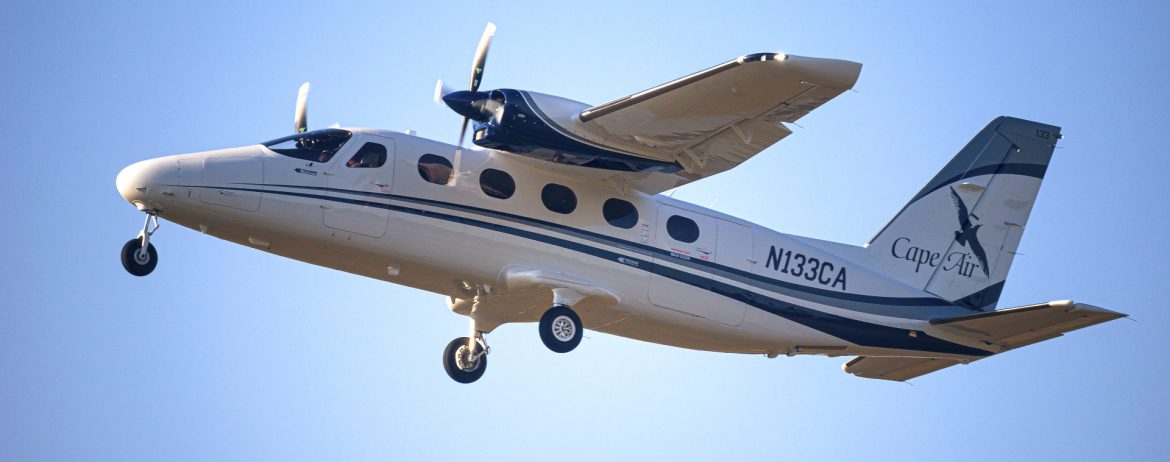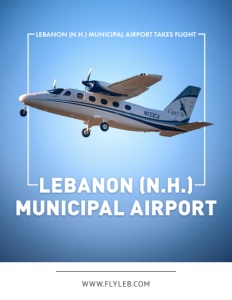Lebanon Municipal Airport
Lebanon (N.H.) Municipal Airport takes flight
Serving the Granite State and beyond
WEST LEBANON, N.H.—The Lebanon Municipal Airport, often referred to simply as “LEB,” is a regional, tower-controlled airport situated in western New Hampshire along the border with Vermont. Daily commercial service connects passengers to Boston and the New York City suburb of White Plains, N.Y. Consisting of 563 acres and located nearby to Dartmouth College, LEB is a hub for those traveling to the Upper Valley (quintessential New England, nestled along the New Hampshire/Vermont border).
We recently spoke with Lebanon Municipal Airport Manager Carl Gross, and he told us all about his job and the airport he proudly serves. Gross explained that during World War II in 1942, the United States War Department approached the City of Lebanon about purchasing some land to create an airport. This was par for the course during the war, when countless such airports became the training grounds for young pilots preparing to fly missions over Europe and the Pacific. Postwar, the airport was deeded back to the City of Lebanon, as Gross informs.
“Since that time,” he adds, “the airport has undergone an expansion of what is now our primary runway. Then the terminal building relocated to the south side of our east-west runway in about 1980. The FBO (fixed-base operator) on the north side was redeveloped just after the terminal relocated. Then, since the 1980’s, we’ve added two banks of T-hangars and developed an additional apron for future hangar development.”
Gross continues that there’s also a business park. Currently the majority of the structures are privately owned. In 2022, the airport expanded the access road to the business park to City property. There are about eight acres of land – available for development for light industrial use.
Gross adds that the airport sees about 30,000 operations a year. An on-site flying club, the Upper Valley Flying Club, provides flight training. Some transient military aircraft come through as well, in particular with regard to Vermont and New Hampshire National Guard units and their helicopters.
The airport features two asphalt runways of 5,496 feet and 5,200 feet in length. He reveals that an ongoing multi-year project, when it comes to fruition, will expand the shorter runway to 5,400 feet. A parallel taxiway will also be completed there, and the localizer will be relocated. A localizer is a device that transmits VHF signals to provide aircraft with lateral guidance, thus allowing pilots to ensure that their planes are properly aligned with the center of the runway during the approach and landing phases of their flights.
Cape Air flies from LEB to Boston-Logan International Airport four times a day, as Gross points out. LEB can accommodate such planes that weigh up to 60,000 lbs., this can be waived for aircraft up to 99,600 lbs., thus bringing in larger corporate craft and some smaller commercial craft.
“We have a good relationship,” he says of Cape Air. “The station crew is really good to work with. I will say Cape Air has been innovative in their thinking.”
He praises the airline’s shuttle service that allows passengers access right into the heart of Manhattan.
LEB stays busy, as Gross notes. Throughout the year, flights come in from as far away as the West Coast, Alaska and Europe.
Granite Air Center is the fixed-based operator. It provides all the fueling, including for Cape Air, and hangar services for corporate aircraft. Granite has a maintenance staff on the field. Open daily, 6 a.m.-10 p.m., it provides very good service with the corporate traffic, says Gross, citing co-ordinating rental cars, catering and more.
“They do a very good job with customer service,” he adds, “just exceptional, from what I’ve seen.”
 Bouncing back
Bouncing back
During the COVID pandemic restrictions, LEB lost nearly two-thirds of its commercial passenger traffic, as Gross reveals. Charter flights, however, helped make up for this.
He also cites the ongoing pilot shortage, which he puts down in large measure to the Baby-Boomers retiring faster than following generations entering the labor market. As a potential solution, some have advocated raising the retirement age for pilots (possibly as high as 70 years of age), but Gross doesn’t think that’s a realistic answer. Gross says that based upon his conversations with pilots, if a younger retirement age is possible, they’ll take it.
He opines that getting rid of the 1,500 hours of flight training rule might help.
“I know that’s sacrilege,” he adds, “but it would make more sense to make that training competency-based, rather than hour-based.” As for their more youthful counterparts, some, especially veterans of recent military experience, are quite accomplished, whereas others need more time. The length of time to acquire competency varies from pilot to pilot.
Gross also discussed infrastructure. He cited the business park.
“We’ve completed a 1,700-foot extension to the roadway through the park that has water, sewer and power running along the length of the road,” he notes.
Further, LEB is among the airports benefitting from federal funding. This will result in a new air traffic control tower.
The airport is less than two miles from the intersection of Interstates 91 and 89. Closeto Dartmouth College (just some seven miles away) and “We’re just a few miles away from the Dartmouth-Hitchcock Medical Center, which is a teaching hospital associated with Dartmouth College,” he adds. “and they do an incredible amount of internal research and research with medical supply firms in the area. We’re in a convenient location for all of these different businesses, and we’re in the Upper Valley region of New Hampshire and Vermont, so we’re right on the border of Vermont. We have towns that rely on the airport on both sides of the border.”
 A bright future
A bright future
The airport’s terminal, built in 1980, is comprised of some 17,000 square feet, says Gross. He adds that improvement projects soon set for completion include renovation to the building’s electrical systems and replacing all of the terminal windows, the exterior siding, interior lighting and the carpeting.
“We made the building brighter and more energy-efficient,” as Gross points out. “We’ve also reconfigured the TSA (Transportation Security Administration) checkpoint here in the terminal building to accommodate some of the newer screening equipment for checked baggage.”
He further adds that for both corporate and general-aviation pilots, Granite Air Center offers first class service.
“They offer conference rooms for people flying in, if they need to meet their local contingent at the airport,” as Gross points out, “and they also offer crew vehicles, crew rest areas and briefing rooms, catering, fueling and hangar space.”
He also notes that the Lebanon Municipal Airport is in a prime location. Looking to the future, he opines that acquiring a major carrier would be very good.
However, achieving that, says Gross, is “really going to depend, I think, on advanced technology and how that changes aviation.”
As an example, he informs that Cape Air is one of the launch customers for an electric-powered commuter called “Alice” that’s made by the Israeli-based Eviation Company. Eviation’s price tag for this revolutionary craft is $4 million each, and Cape Air has already ordered nearly a hundred of them. The “Alice” is designed to accommodate nine passengers and two crew members. First developed in Israel, its construction incorporates some 95 percent of composite material. It is powered by two electric motors, and it features a T-tail. The plane’s first prototype had its maiden voyage in September of last year. It could very well revolutionize the aviation industry.
“It’s due for certification in 2027,” Gross reveals, “so right now, the airport itself is planning how we develop the electrical grid to support the aircraft and also how we support electric aircraft in general. I think we’re going to see a change in aviation and this airport is going to be the electric aircraft field for commuter aircraft.
“Some of the 30 to 50-seat commuter aircraft that are being developed right now look promising,” he continues, “and it looks like one of the big changes you’re going to see with electric aviation is a decrease in operating cost in particular maintenance. Now, you’ve got a nice, smooth-running electric motor compared to an internal combustion engine, which is constantly beating itself. There are fewer moving parts, so I think the future is going to be kind of exciting in this area.”
In the next few years, says Gross, the runway safety project will be complete. The extension of the shorter runway will be finished, and the new air traffic-control tower will be in place. Hopefully, he adds, some new T-hangars will also be in place for local aircraft enthusiasts.
Thus it is that things look sunny ahead for the Lebanon Municipal Airport. It is, says Gross, fair weather for flying indeed.
AT A GLANCE
Lebanon (N.H.) Municipal Airport
What: a city-owned, public-use airport in the western portion of the Granite State
Where: West Lebanon, New Hampshire
Website: www.flyleb.com



